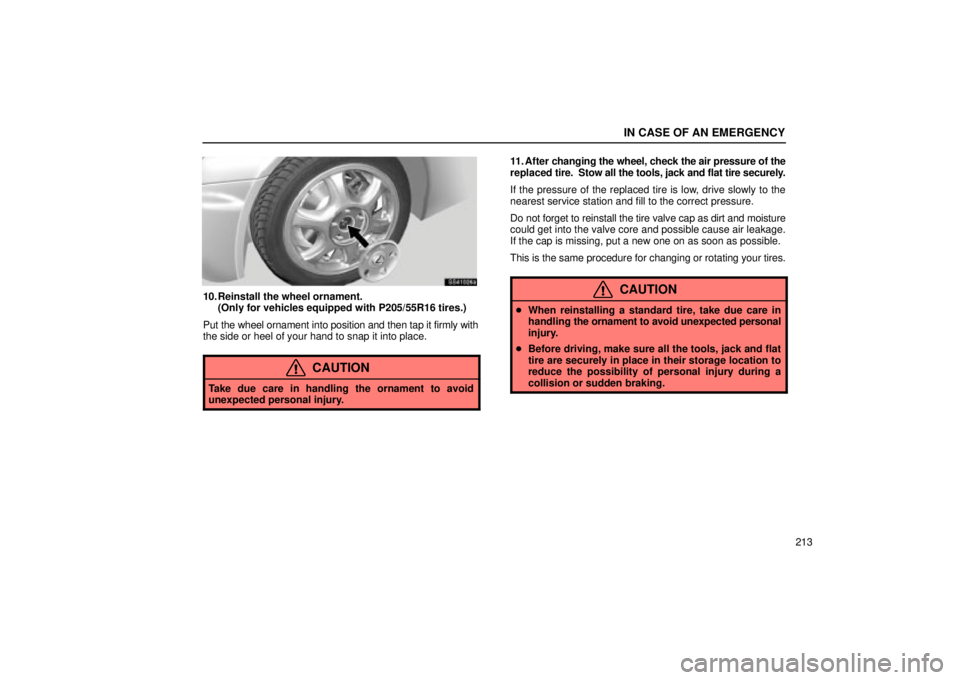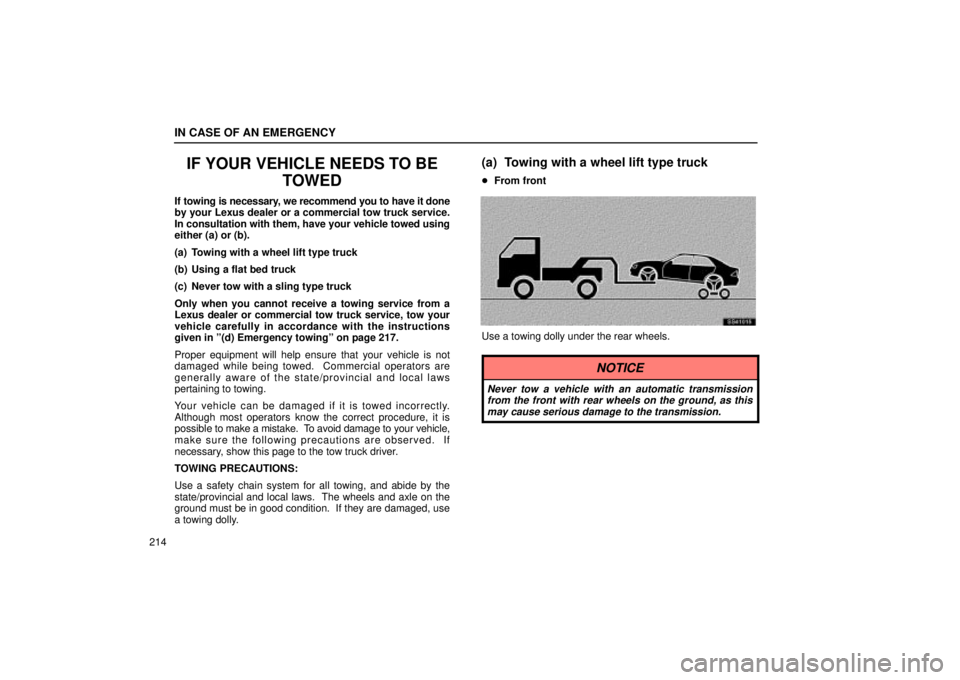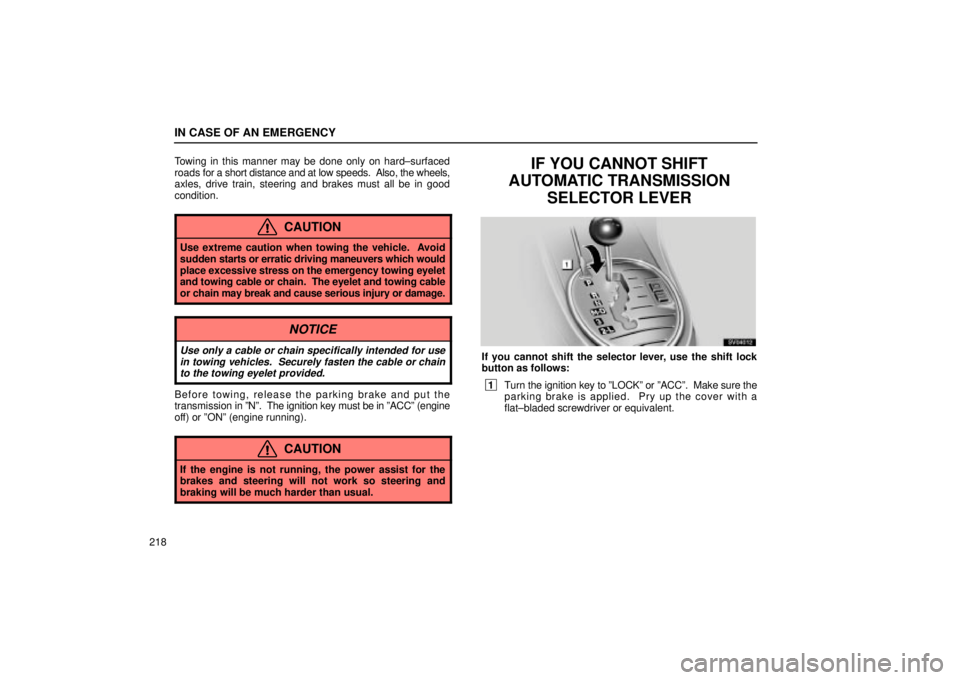Page 221 of 307
IN CASE OF AN EMERGENCY
208
SV04016
To remove the spare tire:
1Remove the tool tray.
2Remove the spare tire cover.
3Loosen the bolt and remove it.
When storing the spare tire, place it with the inner side of the
wheel facing up. Then bolt the tire in place and install the spare
tire cover to prevent the tire from flying forward during a
collision or sudden braking.
SV04018
2. Block the wheel diagonally opposite the flat tire to keep
the vehicle from rolling when it is jacked up.
When blocking the wheel, place a wheel block in front of the
front wheels or behind the rear wheels.
Page 222 of 307
IN CASE OF AN EMERGENCY
209
SS41025
�Paper for protecting surface
3. Remove the wheel ornament.(Only for vehicles equipped with P205/55R16 tires.)
Pry off the wheel ornament, using the screwdriver as shown.
CAUTION
Do not try to pull off the ornament by hand. Take due
care in handling the ornament to avoid unexpected
personal injury.
SS41008
4. Loosen all the wheel nuts.
Always loosen the wheel nuts before raising the vehicle.
Turn the wheel nuts counterclockwise to loosen them. To get
maximum leverage, fit the wrench to the nut so that the handle
is on the right side, as shown above. Grab the wrench near the
end of the handle and pull up on the handle. Be careful that the
wrench does not slip off the nut.
Do not remove the nuts yet ± just unscrew them about one±half
turn.
Page 224 of 307
IN CASE OF AN EMERGENCY
211
SS41011
7. Remove the wheel nuts and remove the flat tire.
Lift the flat tire straight off and put it aside.
SS41027
(Only for vehicles equipped with 215/45R17 tires)
When installing the alloy wheels, at this point, remove the
wheel ornament from the flat tire and replace it on the newly
installed tire.
SS41012
Before putting on the wheel, remove any corrosion on the
mounting surfaces with a wire brush or such. Installation of
wheels without good metal±to±metal contact at the mounting
surface can cause wheel nuts to loosen and eventually cause
a wheel to come off while driving.
Page 225 of 307

IN CASE OF AN EMERGENCY
212
SS41013
8. Reinstall all the wheel nuts finger tight.
Align the holes in the wheel with the bolts. Then lift up the
wheel and get at least the top bolt started through its hole.
Wiggle the tire and press it back over the other bolts.
Reinstall the wheel nuts and tighten them as much as you can
by hand. Press the tire back and see if you can tighten them
more.
SS41014
9. Lower the vehicle completely and tighten the wheel
nuts.
Turn the jack handle counterclockwise to lower the vehicle.
Use only the wheel nut wrench to tighten the nuts. Do not use
other tools or any additional leverage other than your hands,
such as a hammer, pipe or your foot. Make sure the wrench
is securely engaged over the nut.
Tighten each nut a little at a time in the order shown. Repeat
the process until all the nuts are tight.
CAUTION
� When lowering the vehicle, make sure all portions of
your body and all other persons around will not be
injured as the vehicle is lowered to the ground.
� As soon as possible after changing wheels, have the
wheel nuts tightened by torque wrench at 103 N´m
(10.5 kgf´m, 76 ft´lbf.).
Page 226 of 307

IN CASE OF AN EMERGENCY
213
SS41026a
10. Reinstall the wheel ornament.(Only for vehicles equipped with P205/55R16 tires.)
Put the wheel ornament into position and then tap it firmly with
the side or heel of your hand to snap it into place.
CAUTION
Take due care in handling the ornament to avoid
unexpected personal injury.
11. After changing the wheel, check the air pressure of the
replaced tire. Stow all the tools, jack and flat tire securely.
If the pressure of the replaced tire is low, drive slowly to the
nearest service station and fill to the correct pressure.
Do not forget to reinstall the tire valve cap as dirt and moisture
could get into the valve core and possible cause air leakage.
If the cap is missing, put a new one on as soon as possible.
This is the same procedure for changing or rotating your tires.
CAUTION
� When reinstalling a standard tire, take due care in
handling the ornament to avoid unexpected personal
injury.
� Before driving, make sure all the tools, jack and flat
tire are securely in place in their storage location to
reduce the possibility of personal injury during a
collision or sudden braking.
Page 227 of 307

IN CASE OF AN EMERGENCY
214
IF YOUR VEHICLE NEEDS TO BETOWED
If towing is necessary, we recommend you to have it done
by your Lexus dealer or a commercial tow truck service.
In consultation with them, have your vehicle towed using
either (a) or (b).
(a) Towing with a wheel lift type truck
(b) Using a flat bed truck
(c) Never tow with a sling type truck
Only when you cannot receive a towing service from a
Lexus dealer or commercial tow truck service, tow your
vehicle carefully in accordance with the instructions
given in º(d) Emergency towingº on page 217.
Proper equipment will help ensure that your vehicle is not
damaged while being towed. Commercial operators are
generally aware of the state/provincial and local laws
pertaining to towing.
Your vehicle can be damaged if it is towed incorrectly.
Although most operators know the correct procedure, it is
possible to make a mistake. To avoid damage to your vehicle,
make sure the following precautions are observed. If
necessary, show this page to the tow truck driver.
TOWING PRECAUTIONS:
Use a safety chain system for all towing, and abide by the
state/provincial and local laws. The wheels and axle on the
ground must be in good condition. If they are damaged, use
a towing dolly.
(a) Towing with a wheel lift type truck
�From front
SS41015
Use a towing dolly under the rear wheels.
NOTICE
Never tow a vehicle with an automatic transmission
from the front with rear wheels on the ground, as thismay cause serious damage to the transmission.
Page 228 of 307
IN CASE OF AN EMERGENCY
215
�
From rear
SS41016b
Place the ignition key in the ºACCº position.
NOTICE
�Do not tow with the key removed or in the ºLOCKº
position, as the steering lock mechanism is notstrong enough to hold the front wheels straight.
�When lifting wheels, take care to ensure adequateground clearance for towing at the opposite end ofthe raised vehicle. Otherwise, the bumper and/orunderbody of the towed vehicle will be damagedduring towing.
(b) Using a flat bed truck
SS41017
� Tie down points
40E014
Page 231 of 307

IN CASE OF AN EMERGENCY
218Towing in this manner may be done only on hard±surfaced
roads
for a short distance and at low speeds. Also, the wheels,
axles, drive train, steering and brakes must all be in good
condition.
CAUTION
Use extreme caution when towing the vehicle. Avoid
sudden starts or erratic driving maneuvers which would
place excessive stress on the emergency towing eyelet
and towing cable or chain. The eyelet and towing cable
or chain may break and cause serious injury or damage.
NOTICE
Use only a cable or chain specifically intended for use in towing vehicles. Securely fasten the cable or chainto the towing eyelet provided.
Before towing, release the parking brake and put the
transmission in ºNº. The ignition key must be in ºACCº (engine
off) or ºONº (engine running).
CAUTION
If the engine is not running, the power assist for the
brakes and steering will not work so steering and
braking will be much harder than usual.
IF YOU CANNOT SHIFT
AUTOMATIC TRANSMISSION SELECTOR LEVER
SV04012
If you cannot shift the selector lever, use the shift lock
button as follows:
1Turn the ignition key to ºLOCKº or ºACCº. Make sure the
parking brake is applied. Pry up the cover with a
flat±bladed screwdriver or equivalent.